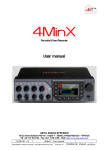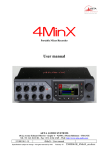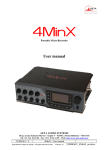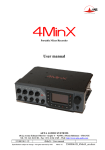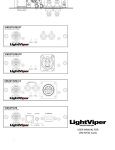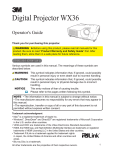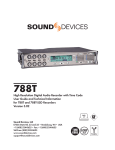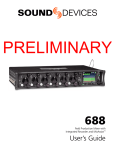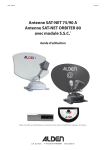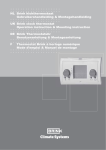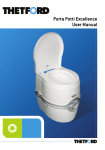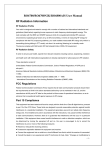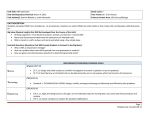Download User manual - Sound
Transcript
4MinX Portable M ixer/Recorder
User manual
AETA AUDI O SYSTEM S
18-22, avenue Edouard Herriot ± Kepler 4 ± 92350 Le Plessis Robinson ± FRANCE
Tél. +33 1 41 36 12 00 ± Fax +33 1 41 36 12 69 ± Web: http://www.aeta-audio.com
55 000 061 - J
4MinX - User manual
Specifications subject to change ± All rights reserved by AAS
April 14
55000061J_4MinX_en.docx
I ndex
1. Technical Characteristic...........................................................2 2. AUDI O I nterfaces......................................................................3 2.1. Audio Inputs ................................................................................................. 3 2.1.1. ,QSXW³0LF/LQH´ ................................................................................... 3 2.1.2. Line inputs/return .................................................................................. 6 2.1.3. (PEDVH³(;7,2´5pFHSWHXUV+) ...................................................... 6 2.1.4. AES Inputs ............................................................................................ 7 2.2. Audio outputs ............................................................................................... 7 2.2.1. 0DLQRXWSXWV³/LQH2XW´ ....................................................................... 7 2.2.2. UQEDODQFHG³/LQH2XW´ ......................................................................... 7 2.2.3. Analog outputs for radio transmitters .................................................... 8 2.2.4. Digital outputs ....................................................................................... 8 2.3. Monitor ......................................................................................................... 9 2.3.1. Display screen ....................................................................................... 9 2.3.2. Configuration ...................................................................................... 10 2.3.3. Headphone monitoring ........................................................................ 12 2.4. Internal alignment signal generator ............................................................ 12 2.5. Intercom / Slate microphone ....................................................................... 13 3. Powering...................................................................................14 3.1. Specifications.............................................................................................. 14 3.2. Switching on and off ................................................................................... 15 4. M enu description .....................................................................16 4.1. General principles ....................................................................................... 16 4.2. Menu structure ............................................................................................ 17 4.3. Menu : « Audio » ........................................................................................ 19 4.3.1. Menu : « Audio Inputs » ...................................................................... 19 4.3.2. Menu : « Audio Output » ................................................................... 20 4.3.3. Menu : « Coupling » ............................................................................ 20 4.3.4. Menu: « Routing » ............................................................................... 21 Mixdown bus ............................................................................................ 21 Auxiliary bus............................................................................................. 21 Monitoring bus .......................................................................................... 22 Output sources .......................................................................................... 22 Slate .......................................................................................................... 22 55 000 061 - J
4MinX - User manual
4.3.5. Menu : « P1-P4 function » .................................................................. 22 4.3.6. MIDI Menu ......................................................................................... 23 4.3.7. Menu « Master gain» ......................................................................... 25 4.3.8. Menu « Mixdown Limiter» ................................................................. 25 4.4. Menu : « Recording » ................................................................................. 25 4.4.1. Menu: « Project Management » ......................................................... 25 4.4.2. Menu : « File Management ................................................................. 28 4.4.3. Menu : « Filename template »............................................................. 31 4.4.4. Menu : « Meta data » .......................................................................... 31 Edition interface ........................................................................................ 32 Automatic note .......................................................................................... 33 Recording type .......................................................................................... 33 Canvas ....................................................................................................... 33 Sources names ........................................................................................... 34 4.4.5. Menu : « File format » ........................................................................ 34 4.4.6. Menu : « Pre-record » ......................................................................... 34 4.4.7. Menu : « Backup False take » ............................................................. 35 4.4.8. Menu « Backup to USB » ................................................................... 35 4.5. Menu « Settings »....................................................................................... 36 4.5.1. Menu : « Synchronization » ................................................................ 36 4.5.2. Menu : Time Code ( Option).............................................................. 37 4.5.3. Menu : « Snapshots » .......................................................................... 38 4.5.4. Menu : « Tone » .................................................................................. 38 4.5.5. Menu : « Display ».............................................................................. 38 4.5.6. Menu : Function keys.......................................................................... 38 4.6. Menu : « Tools » ........................................................................................ 39 4.6.1. Menu : Power down ........................................................................... 39 4.6.2. Menu : Sleep ...................................................................................... 39 4.6.3. Menu : Eject media ............................................................................ 39 4.6.4. Menu : Reset settings ......................................................................... 40 4.6.5. Menu : Import/export configurations ................................................. 40 Project........................................................................................................ 40 Settings ...................................................................................................... 40 Debug ........................................................................................................ 40 4.6.6. Menu : Format media ......................................................................... 40 4.6.7. Warning .............................................................................................. 41 4.6.8. Update ................................................................................................. 41 5. Operating mode ± Detailed description................................. 42 5.1. Interface ..................................................................................................... 42 5.2. Start a record .............................................................................................. 43 4MinX - User manual
55 000 061 - J
5.3. Play a take ................................................................................................... 44 5.3.1. Navigation ........................................................................................... 44 5.3.2. Play ...................................................................................................... 44 5.3.3. Monitoring ........................................................................................... 45 5.3.4. Mix, Cue bus. ...................................................................................... 45 5.3.5. Search or modify a take ....................................................................... 46 5.4. Shortcuts ..................................................................................................... 47 5.5. Quick Screens/configurations ..................................................................... 47 5.5.1. Inputs configuration ............................................................................ 48 5.5.2. Audio Routing ..................................................................................... 49 5.5.3. Audio lock potentiometers .................................................................. 50 5.6. Snapshots .................................................................................................... 50 5.6.1. Save / Load .......................................................................................... 51 5.6.2. Export .................................................................................................. 51 5.6.3. Import .................................................................................................. 52 6. Audio couplings .......................................................................53 6.1. Microphones ............................................................................................... 53 6.1.1. Monophonic ........................................................................................ 53 6.1.2. Stereophonic ........................................................................................ 54 6.1.3. Surround .............................................................................................. 55 6.2. Stereo coupling ........................................................................................... 57 6.3. M/S coupling .............................................................................................. 58 6.4. Double M/S coupling .................................................................................. 59 6.5. Link all 1 to 4.............................................................................................. 61 6.6. Soundfield A/B format (Optional) .............................................................. 62 7. Technical Specifications..........................................................66 7.1. Microphone/Line inputs .............................................................................. 66 7.2. Line input .................................................................................................... 67 7.3. AES inputs .................................................................................................. 67 7.4. "Line Out" balanced analog outputs ........................................................... 68 7.5. "Line Out" unbalanced analog outputs ....................................................... 69 7.6. Digial outputs ............................................................................................. 69 7.7. Headphone output ....................................................................................... 70 7.8. "Direct I/O" interface .................................................................................. 70 7.9. "EXT I/O": Interface for RF transmitters/receivers .................................... 71 55 000 061 - J
4MinX - User manual
7.10. Power supply ............................................................................................ 72 7.11. Time Code ................................................................................................ 72 7.12. Environmental .......................................................................................... 73 7.13. Hirose 10Pins option ................................................................................ 74 8. Annexes .................................................................................... 75 8.1. iXML .......................................................................................................... 75 8.2. Overview of connectors and front panel elements ..................................... 77 8.3. Block diagram ............................................................................................ 80 8.4. Level maps ................................................................................................. 82 8.5. Filters ......................................................................................................... 83 8.6. Limiter ........................................................................................................ 84 8.7. Accessories ................................................................................................. 85 9. Notes ......................................................................................... 89 Revision:
J ± Build on firmware V1.7.5
4MinX - User manual
55 000 061 - J
Introduction
4MINX is a portable mixer specially designed for outside recording.
4Minx is new kind of product on this market. It can be use as a traditional
mixer, but can be use as a multi tracks recorder. In same time, it can manage
digital audio treatment in real time.
This equipment is suitable for sound production, with its remarkable audio
features and its full compatibility with « M/S » and « surround » systems.
4Minx have 4 Mic/Line inputs, with all power phantom and limitor, 2 digital
inputs AES3. Digital inputs support the normalization AES42 for digital
microphones (10v phantom power).
4Minx has many outputs, 6 analog channels and 6 digital channels AES3.
The routing capability for each input and each output give complete liberty to
the user.
The multi tracks recorder can grow up to 8 tracks on SD/SDHC card and can
make a backup on external USB disk. You should use SD/SDHC card Class 10
or similar to avoid problems.
A project management included in the unit gives the opportunity to make many
sounds recording without problem.
4MinX KDVDNH\ERDUGDQGD´TFT high quality display, offer a simple and
nice user interface. On 4Minx the user can set its own mixer interface in regards
inputs and outputs need in his configuration.
To start a work quickly, you can read the quick start delivery with the unit. It
will provide you all details step by step to start a record.
55 000 061 ± J
4MinX - User manual
1
1. Technical Characteristic
x
x
x
x
x
Light weight and small dimensions (1.9 kg, 260 x 75 x 195 mm)
x
x
x
x
x
x
x
x
Maximum input level: +19 dBu without pad
x
x
x
separate Stereo l M/S encoders/decoders, for monitoring
x
High performance headphone amplifier, with selectable source and
listening mode
x
x
x
Long operating range on Li-Ion DV battery and charger inside
4 Mic/Line transformerless inputs, very low noise (-128dBu)
Adjustable input gain, 10 dB steps, 0 to +50 dB
High-pass filters on each channel
Maximum overall gain: 90 dB, useful for dynamic and ribbon
microphones
Input headroom: 40 dB, independent of input stage gain
LED for overload warning on each input channel
Fast limiter on each input, 40 dB operating range, with LED indicator
Stereo or M/S coupling on inputs 1&2 et 3&4
Stereo l M/S encoder/decoder on inputs 1 & 2, 3 & 4
4 main line outputs, maximum level adjustable from -9dBu to +22dBu
2 return or auxiliary line inputs, maximum acceptable level adjustable
from -9dBu to +22dBu ( for 0dBFS)
2 unbalanced outputs (level 6 dB below the balanced outputs)
´49*$7)7VFUHHQZLWKDGMXVWDEOHEULJKWQHVVGLVSOD\LQJODUJH
scale bargraphs (50 dB dynamic range)
3 AES3 digital outputs, stereo, 24 bits, up to 96 kHz
2 AES3 digital inputs with phantom +10V for AES42 microphones
with sample rate convertor.
2
4MinX - User manual
55 000 061 - J
2. AUDIO Interfaces
The functions of the analog and digital mixer are shown on the functional
diagram that can be found in annex,³Block diagram´2QQH[WSDUDJUDSKZH
will describe in detail all inputs and outputs of the 4MinX
2.1. Audio Inputs
2.1.1. ,QSXW³0LF/LQH´
Each of these four inputs is available on a 3-pin female XLR socket, and
is electronically balanced. Each input support 48V phantom power or T12
power. If no powering is active, unbalancing an input has no negative impact on
the performance.
. Each input has its own volume control on the front panel, generally
named « fader ».
Specificities:
- ,QSXWVDQGFDQDOVREHIHGIURPWKH³(;7,2´VRFNHWLQZKLFK
case no microphone powering is available
- Input 1 and 2 can stand very strong audio levels thanks to a 20 dB
attenuator. When it is enable, the input level can grow up to +39dBu.
)XQFWLRQVRIWKH³0,&/LQH´LQSXWV
The following functions are available on each input, via a selection in the menu:
55 000 061 ± J
4MinX - User manual
3
x
x
x
x
Input stage gain setting, 0dB to +50dB, 10dB steps;
x
x
x
Polarity inversion (phase reversal)
x
x
x
7KH³ULVNRIRYHUORDG´/('EHJLQVWROLJKWDW dB below overhead.
3KDQWRPSRZHUIRUDPLFURSKRQH9RU³7RQDGHU 9´ ;
Analog high-pass filtering, 50 Hz cut-off frequency, 18dB/octave;
Digital high-pas filtering, 50 Hz to 200Hz 12dB/octave and 300 Hz,
6dB/octave, suitable for compensating proximity effects in directional
microphones
)DVWOLPLWLQJZLWK³VRIWNQHH´
Routing to Left or Right bus, or Center (i.e. L and R), with pan-pot, or
not routed at all
Attenuator ( 20dB ) can be enable on the mic/line input 1 & 2
Delay between 0 to 7ms by 0.1ms step
Note:
-
The 50Hz analog filter can be enabling in the same time as the digital
filtering. In this case rate will be 32dB/Oct below 50Hz.
A limiter can be inserted into each channel (post-fader). Its activation
is shown by a green LED that turns red when the signal begins to limit.
-
Stereo and M/S
Via menu selection, channels 1 and 2, 3 and 4 can be used as
independent channels or coupled for stereo or M/S operation. When used as a
couple of stereo or M/S channels, the channel impair becomes the master,
controlling the level of both channels. The channel pair provides +/-5dB
adjustment of the balance in L/R mode (normal stereo), or the stereo width in
M/S mode.
I n normal stereo mode, the transducers usually have matching sensitivity:
4
x
Any change of the input gain on one channel induces the same on
the other channel;
x
The even channel control controls the balance between L and R
channels by +/- 6dB
4MinX - User manual
55 000 061 - J
x
Input odd is routed to the Left bus, input pair is routed to the
Right bus
x
The even input is routed on the mix down Left and the odd on
the mix down right. But, Over writing these routing remains
possible!
,Q³06´PRGH the transducers often have different sensitivity:
x
x
x
The input gain adjustment is kept separate for channels odd and
even,
The odd channel control adjust the couple level
The event channel control adjusts the stereo image width. In the
center detent position, a coherent couple should provide a
normalized 110° angle
x
Whenever inverting the phase of channel even, after decoding
from M/S to L/R the stereo image is reserved LlR
x
Manual routing is inhibited and the signals are routed and
decoded as follows:
,QSXWLPSDLULVWKH³0´VLJQDOLQSXWSDLULVWKH³6´VLJQDO
Input impair + Input pair (M+S) is routed to the Left bus;
Input impair - Input pair (M-S) is routed to the Right bus.
Limiters
A limiter can be inserted into each channel, after the channel fader. This is a
fast limiter with a dynamic range wide enough to stand the 40 dB overhead of
the input stage. The activation of the limiter is shown by an LED.
As long as the signal level stays below the limiter threshold, little effect is seen
on the signal. When the limiter is triggered, its output stays 6dBFS below the
A/D converter clipping level for up to 40dB input overdrive.
,WFDQWKXVEHVHHQDVD³VDIHW\´OLPLWHUWKDWPD\EHOHIWDFWLYHDOOWKHWLPH
The threshold can be adjusted through the menu from ±12dBFS to ±3dBFS
55 000 061 ± J
4MinX - User manual
5
Note: In case of use specific coupling the limiters are coupling together, which
is the required mode for applying simultaneous and identical gain reduction to
both channels in « stereo » and M/S modes, in order to preserve the coherence
of the stereo image.
2.1.2. Line inputs/return
Two inputs are available on a 5-pin female XLR socket, and are electronically
balanced. It is possible to unbalance an input without negative impact on the
performance. Each channel has its own maximum level adjustment in the menu
from -9dBu to +22dBu (for 0dBFS). Theses inputs can be use as a return from
video camera but can be use as more analog entries for the mix down or the
recorder. It is possible to have a fader control on each input through P1 to P4. In
this case, we provide you 15dB more gain.
Theses inputs have digital high-pas filtering, 50 Hz to 200Hz 12dB/octave and
300 Hz, 6dB/octave, suitable for compensating proximity effects in directional
microphones
Delay can be inserted on theses inputs. The delay can be set between 0
and 7ms by 0.1ms step.
2.1.3. (PEDVH³(;7,2´5pFHSWHXUV+)
7KH³(;7,2´ socket is available for the connection of an optional
extension box. This device can be used to interface 4MINX with radio
transmitters and/or receivers.
:KHQWKHH[WHQVLRQGHYLFHLVSOXJJHGLQWRWKH³(;7,2´VRFNHWWKH
mixer can use, for channels 3 and/or 4, inputs from the EXT I/O socket instead
of XLR inputs 3 and 4. In this case NO microphone power is apply on these
inputs.
The extension device feeds these inputs with two balanced signals. For
safety, no microphone powering is inserted into these inputs on the EXT I/O
socket but all others settings are the same.
On this interface, you have 2 asymmetrical outputs. Theses outputs are
described on the need paragraph.
6
4MinX - User manual
55 000 061 - J
Note: A 9V/ 600mA power supply is available on the connector.
2.1.4. AES Inputs
4MINX can accept AES3 digital audio input on its « Dig. In » (XLR 3 pins).
Signals can be routed or mixed in the bus as others inputs or send to any
outputs.
The input 1&2 can be used to synchronize the 4minx on another machine. This
feature can be set in the synchronization menu, it is necessary to specified in the
same menu the frequency of the AES signal. Both digital inputs are using a
sample rate convertor when you are in master mode.
Note: Don't forget to set the right sample frequency on the synchronization
menu when you want to use the AES input as synchronization
Theses inputs have digital high-pas filtering, 50 Hz to 200Hz 12dB/octave and
300 Hz, 6dB/octave, suitable for compensating proximity effects in directional
microphones
Delay can be inserted on theses inputs. The delay can be set between 0
and 7ms by 0.1ms step.
2.2. Audio outputs
2.2.1. 0DLQRXWSXWV³/LQH2XW´
4Minx have 2 stereo line outputs on XLR 5 pins. By menu, you can set
source for each channels between all inputs, bus, monitoring.
The signals are electronically balanced; they can be unbalanced with no
impact on performance, as long as the level stays below +19dBu.
The maximum output level (which corresponds to the maximum digital
level, 0dBFS) is adjustable via the menu, from -9dBu to +22dBu.
Also via the menu, a 40dB attenuator can be inserted on each output
FKDQQHOVRSURYLGLQJD³PLFURSKRQHOHYHO´VLJQDO.
2.2.2. 8QEDODQFHG³/LQH2XW´
55 000 061 ± J
4MinX - User manual
7
7KHVDPHVLJQDOVRIWKHILUVW³VWHUHR´OLQHRXWSXWDVIRXQGRQWKH;/50
socket are also fed to a 3.5mm stereo mini-jack socket. These signals are
unbalanced, and their level is 6dB below those on the balanced XLR5M .Their
typical use is for linking the mixer to a semi-professional recorder (Mini-Disc,
FDVVHWWH'$7«RUFRQQHFWLQJDVHFRQGKHDGSKRQH
2.2.3. Analog outputs for radio transmitters
The L and R mix buses or any inputs can output on the « EXT I/O »
socket (on the left side of the unit), with a separate adjustment of the maximum
level for each channel from -20dBu to +10dBu, which allows a suitable
adaptation to most radio transmitters. These outputs are asymmetrical.
2.2.4. Digital outputs
4MINX delivers 24-bit stereo digital outputs; it is possible (via the menu) to
VHOHFWHLWKHUD³3UR´PRGHRU³&RQVXPHU´PRGHGHSHQGLQJRQWKHW\SH of
equipment the signals are fed to.
A balanced and transformer isolated AES output (110Ohm impedance) is
DYDLODEOHRQWKH³'LJ 2XW´VRFNHW It is possible to connect this AES output to a
SPDIF input through an adaptor cable (optional: see Annex).
8
4MinX - User manual
55 000 061 - J
2.3. Monitor
2.3.1. Display screen
7KHGLVSOD\VFUHHQRI0,1;LVD´FRORU49*$7)7GLVSOD\7KLV
technology features a very wide viewing angle and fast response time. The
display brightness is adjustable, it has latest technology for a perfect outside
used.
On the main screen:
- The monitoring audio level of left and right signals are showing at the
bottom of the display
- Just over them the level of the four microphone inputs in post and pre
fader are shown.
-
-
Levels are displayed on large scale bargraphs covering -50dBFS to
0dBFS.
By menu you can set 4 metering level threshold (Minimum, nominal,
yellow, red)
They are measured with fast PPM ballistics.
In addition, peaks are held on for about 4 VHFRQG³SHDN-KROG´
function)
$Q³29/´LFRQVKRZVXSZKHQever the level reaches -3dBFS or more.
Input number are display in red when you enable a coupling between
us (when 2 stereo or M/S coupling are selected, the second is show in
blue).
,I\RXVHOHFWSUHIDGHUE\PHQXIRUWKHLQSXWDµP¶ is display
55 000 061 ± J
4MinX - User manual
9
2.3.2. Configuration
The « Monitor » function allows the selection of signals inside 4MINX for
displaying their levels on the screen and monitoring them on headphones
Just by pressing monitor key and moving the rotary, you can select the
following signal sources for monitoring:
x
x
x
x
x
Input 1 to 4, in post or in pre fader
Channel couple : AES 1&2, AES 3&4
Return/Line In couple of signals
Bus
«
Note: The selection can
be affected on one of
function key ( F1 to F4)
by a press on it.
A second bank is
available by pressing the
Shift
You have a total of 8
monitoring presets
Note: When presets are
available, you should
press twice the monitoring
key to access to this menu.
Note: press the monitoring key to swap between sources and mode.
10
4MinX - User manual
55 000 061 - J
To set a shortcut key, you have just to press it under this display. The current
selected source and mode will be saving on this shortcut key.
Example: Set preset F1
55 000 061 ± J
4MinX - User manual
11
2.3.3. Headphone monitoring
The headphone can be plugged into a stereo 6,35mm jack socket. By pressing
twice the monitoring key and vertically moving the cursor with the rotary, the
monitor mode can be selected among the following:
x
x
x
x
L/R : Normal stereo listening ;
x
x
M+S : M+S sum (normally left signal) on both ears ;
L/L: left signal on both ears ;
R/R: right signal on both ears ;
L+R : mono sum (L+R) on both ears;
(useful for mono compatibility and phase coherence checking)
x
M-S : M-S sum (normally right signal) on both ears ;
M/S: listening of encoded signals (sum and difference)
The L/RlM/S matrixing is used for example to listen a conventional stereo
signal (L/R) when monitoring M/S microphones, or when monitoring outputs
that have been M/S encoded.
x
Alternatively, when the mixer is operated in normal stereo mode,
encoding the signals for monitoring can be used to check the stereo
correlation, by comparing the relative amplitude of the M and S signals
2.4. Internal alignment signal generator
An integrated double oscillator can deliver a sinusoidal 1 kHz on the left and a
400Hz on the right to outputs. This can be used to align analog equipment
connected to these outputs. This signal is activated on all outputs (analog and
digital).
The peak level of the generator is -18dBFS (EBU digital reference level) by
default but can be adjusted by menu from (-20dBFs to 0dBFS).
A function key can be set to have a direct access to the
12
4MinX - User manual
55 000 061 - J
2.5. Intercom / Slate microphone
$PLFURSKRQHLVLQWHJUDWHGLQ0,1;¶VIURQWSDQHOLWVDPSOLILHGVLJQDOFDQEH
inserted into the analog/digital outputs (replacing the normal audio signals). See
audio routing, Slate.
A function key can be set to have a direct access to the feature.
55 000 061 ± J
4MinX - User manual
13
3. Powering
3.1. Specifications
4MINX operates from Li-Ion DV battery type NPF-9x0. The integrated charger
can recharge it from an external DC supply in less than 7 hours (depending of
the battery capability).
The DC/Bat LED becomes red to show the proper operation of the internal
charger. This LED becomes green at the end of the charge. If you don't want to
charge the battery, you should use a dedicated power cable without connection
on the Charger dc input pin (See connectors paragraphs), which may be
desirable e.g. if the external source is itself derived from a battery pack.
4MINX can operate from an external source of 8 V to 18 V DC voltage.
4MINX draws constant power from the external source when the voltage
changes. 10V minimum is need for charging.
The same LED becomes green to indicate the presence of the external
power source. 4MINX switches automatically between its internal battery and
the external source, without any noise (priority is given to the external source
when it is available!)
The low battery level can be adjusted by menu from 6,9v to 7,3v. When this
threshold is reached, a warning message is display on the screen and the
battery icon is set in red.
Whenever the battery voltage goes down to 6.9 V, 4M I NX is automatically
shut off. This prevents damaging the battery by discharging it too deeply.
0,1;¶VSRZHUFRQVXPSWion and hence its battery range depend much on the
operating conditions, such as the number and powering mode of the
microphones, headphone impedance and listening level, etc.
However, as an example, starting with a full charged battery, 4MINX will
operate for at least 7 hours (Sony NP-F970) with dynamic microphones
(including ribbon microphones) and a 600 : headphone. In such condition,
4MINX draws less than 500mA from a 14.4V external source.
4MINX draws a near-constant power (not a constant current) from the external
source when the voltage varies
14
4MinX - User manual
55 000 061 - J
3.2. Switching on and off
+ROGGRZQWKH³(VF´EXWWRQIRUPRUHWKDQVHFRQGVWKHVFUHHQZLOOOLJKWXS
and display the AAS logo after few seconds and after the application start.
To switch off the unit, you can go in the menu tools and select power
down2U\RXFDQSUHVV³(VF´GXULQJVDQGSUHVV)WRFRQILUPLike that, you
will preserve the integrity of the systems and limits the risks to have defective
audio files.
Note: It is possible to switch off the unit E\KROGLQJGRZQWKH³(VF´EXWWRQIRU
more than 10 seconds. This should be use only for emergy used.
55 000 061 ± J
4MinX - User manual
15
4. Menu description
4.1. General principles
7RHQWHUWKHPHQXVSXVKMXVWVKRUWO\WKLVWLPHWKH³(VF´EXWWRQ7KHPDLQ
menu is then displayed. Pressing again tKH³(VF´EXWWRQEULQJV\RXEDFNWRWKH
normal meter display mode
You can navigate inside the menus and across lists using the rotary.
To change an item, first move towards it using the rotary until the item is
highlighted; then select the item by pressinJWKH³2.´EXWWRQRUSXVKGRZQWKH
rotary. Change the selected item or value using the rotary, and press again the
³2.´EXWWRQWRFRQILUPWKHFKDQJH
3UHVVWKH³6KLIW´EXWWRQWROHDYHDPHQXIURPRQHOHYHO
3UHVVWKH³(VF´EXWWRQWROHDYHDPHQXUHSHDWWKH press to return to the normal
meter screen
In some case, F1 to F4 keys can be used as function key
On the main menu level, many quick accesses are defined. They give you a
direct access on some settings:
- For Audio menu:
o Micro/line input configuration status
o Line input configuration status
o AES input configuration status
- For Records menu
o File management
- For Settings menu
o Load snapshots
o Bargraphs configurations
16
4MinX - User manual
55 000 061 - J
4.2. Menu structure
The menu is divided in 4 sections
Audio configuration with
« Audio input » : Analog and digital inputs settings
« Audio Output » : Analog outputs settings
« Coupling » : analog input coupling between input 1 to 4
« Routing » : Output routing & bus mixing
« P1-P4 » : P1 to P4 potentiometers function
« Master » : Master gain level
« Mixdown limiter» : Limiter/Compressor configuration
Recordings
« Project management » : To create, delete and modifie a project
« Settings »
« File management » : Configuration of recorded files
« Filename template » : template of recorded files
« Meta Data » : Management and entry of medata for BWF files
« Backup to USB »: Enable the backup of the current working day
on an USB disk.
55 000 061 ± J
« File format » : Configuration of number of bites in the files
4MinX - User manual
17
« Backup false take » : Enable false take backup
³3DXVHIXQFWLRQ´(QDEOHSDXVHGXULQJUHFRUGRUQRW
³5(&NH\VHFXULW\´(QDEOHGRXEOH5(&NH\SUHVVWRVWDUW
recording
Settings
« Synchronization » :to set synchronization source and the sample
rate frequency
« Tone generator » : Adjust the tone generator level
«Snapshots« : Manage snapshots (user memories )
« Time code » : Set all time code configuration: mode and video
rate
« Display settings » :
« Pre-record » : pre record time configuration
Configuration of bargraphs and brightness adjustment
Adjust the font size for menu
« Function keys » : Assign feature on assignable F1 to F4 key
« USB keyboard » : keyboard language selection
«Recording BIP» : Enable/disable BIP on record start and stop
« Date » : To change the system date
« Time » : To change the system hour
« Keyboard auto lock » : Automatic lock of the - and + keys after
10s
Tools
« Power down » : to switch off the unit
« Format media » : to format the SD card
18
« Sleep» : to put the 4Minx in Sleeping mode
« Eject media »: Unmount SD card and USB disk before removing
it from its holster. NEEDED TO AVOID PROBLEMS
« Reset settings » : Load factory configuration
4MinX - User manual
55 000 061 - J
« Import » : Load settings and projects form the SD card
« Update firmware » : update the firmware from the SD card
« Warning Threshold» : Set threshold warning level of the battery,
the external DC level and the disk space
About
« Export » : Export settings and projects to the SD card
Show system information : version, configuration, IP address
Shortcut list : Show shortcut key features
4.3. Menu : « Audio »
-
4.3.1. Menu : « Audio Inputs »
For each microphone 1 to 4
o The microphone gain can be set from 0 to +50dB by 10dB
step
o An analog filter at 50Hz 18dB/Octave can be enable
o Digital filter at 50Hz to 200Hz 18dB/Octave and
30Hz/6dB/Octave can be enable
o A limiter can be enable
o A 48Volts phantom power can be enable or a Tonader 12V.
o The phases can be inverted
o Specific settings for microphone input 1 and 2: An 20dB
attenuator (PAD) can be enable.
o Specific settings for microphone input 3 and 4 : The input
connectors can be switch from standard XLR 3 pin to the
MiniCon 12 pins
-
For the line inputs (1 and 2)
o The maximum level can be set between -9dBu and +22dBu
o Digital filter at 50Hz to 200Hz 18dB/Octave and
30Hz/6dB/Octave can be enable
-
For each AES inputs ( 1&2 and 3&4 )
55 000 061 ± J
4MinX - User manual
19
o
o
o
-
10V phantom poser can be enable ( AES42 normalization)
A fixed gain can be set between 0dB to 36dB by 6dB steps
Digital filter at 50Hz to 200Hz 18dB/Octave and
30Hz/6dB/Octave can be enable
« Delays » : Add delay from 0 to 7ms by 0.1ms step on each input (all
Analog and digital inputs). The new delay selection is applied
immediately after its selection by OK. The value enter by the user is
the delay of the external unit connected on the input. ie the latency on
this input is equal to the maximum latency request on all inputs minus
the value enter on this input.
7KHVDPHGHOD\LVDSSOLHGRQPLFURSKRQHSUHDQGSRVWIDGHU:HGRQ¶W
take in care microphone coupling. The user should set it manually for
each input. All values are saved in snapshots.
-
« Limiter Threshold » : Adjust the microphone limiter threshold
between -3dBFs to -12dBFs, -6dB is the minimum value to accept the
full dynamic input range.
4.3.2. Menu : « Audio Output »
-
For each line from 1 to 4
o The maximum output level can be set between -9dBu to
+22dBu
o A 40dB attenuator can be added.
-
For each Extended outputs on I/O connector (MiniCon)
o The maximum output level can be set between -20dBu to
+10dBu
o « AES out mode » : AES format : « Pro » or « Consumer »
4.3.3. Menu : « Coupling »
In this menu you can select microphone coupling between:
20
4MinX - User manual
55 000 061 - J
For 2 inputs: Stereo or M/S coupling on inputs 1&2 or 3&4
For 3 inputs: Double M/S, inputs 1&2&3
For 4 inputs:
Link between 1-2-3-4
SoundField A for SPS200 ( option soundfield)
B format ( option soundfield)
By default there are no couplings.
o
o
o
4.3.4. Menu: « Routing »
Mixdown bus
Under this menu, we can set inputs sources mixing together in the
stereo bus (Mix down) You can manage correctly mono and stereo sources in
this bus.
Auxiliary bus
You have a second mixing bus for local diffusion. You can send it on analog
and digital outputs. Only mono source can be managed correctly in this bus
The master has no effect on the auxiliary bus. An automatic attenuation is made
depending of the number of selected sources.
Number of channels mixed
into AUX bus
Attenuation
1
0dB
2
-6.6dB
3
-10dB
4
-12dB
5&6
-14.4dB
More
-17dB
55 000 061 ± J
4MinX - User manual
21
Monitoring bus
You have a third mixing bus for monitoring CUE. You can send it on analog
and digital outputs. Only mono source can be managed correctly in this bus
The master has no effect on the monitoring bus. There are no automatic
attenuation.
Output sources
For each analog and digital output you can select one of any inputs, mixing bus,
monitor or play back sources
Slate
Last point, you can specify on witch outputs the slate will be send. You can
send also it in the mixdown, auxiliary bus and in all recorded tracks.
Note: the slate replace the original routing on all programmed destination
4.3.5. Menu : « P1-P4 function »
Under this menu, you can assign many features on the P1 to P4 potentiometers
1.
2.
3.
22
You can have a panpot feature on the microphone input 1 to 4.
When you select this feature, the selected input is automatically
routed in the mix down with panpot. When you disable it, the
selected input is routed in L&R in the mix down.
You can configure a gain adjustment on the input line 1 & 2, both
can be coupled on a single potentiometer or separated on 2
potentiometers. The line input accepts a maximum level of +
24dBu and gain adjustment covers a range of + 15dB to-90dB
You can configure a gain adjustment on the AES input 1&2 or
3&4. Each couple can be coupled on a single potentiometer or
separated on 2 potentiometers. The gain adjustment covers a range
of + 15dB to-90dB.
4MinX - User manual
55 000 061 - J
4.3.6. MIDI Menu
Menu will allow you to transfer control of audio interfaces on a control surface.
4Minx support 2 control surfaces:
-
Korg nanoKONTROL2
-
55 000 061 ± J
4MinX - User manual
23
-
Behringer BCF2000
Each of these surfaces can control 8 channels simultaneously. Channels, as on
the 4Minx, can be coupled or not.
Example: Mic/line1&2 coupling
Channels 1 to 4 control mic / line 1 to 4 inputs; channels 5 & 6 control line
inputs and finally channels 7 & 8 control AES 1 & 2 inputs.
For each channel you disposed of two actuators: a linear fader and a rotary
encoder. The encoder is primarily to adjust the input sensitivity.
For more information on management, see chapter management couplings
24
4MinX - User manual
55 000 061 - J
Some keys are also used on the midi control surface:
- REC: press twice to record. The pause is also available if the feature
is enabled in the menu.
- STOP: press twice to stop recording
4.3.7. Menu « Master gain»
You can enabled or disable the front panel master potentiometer with this menu.
The master affect only the mixdown ( main BUS )
For the fixed choice, you can set its gain between -12dB and +12dB by 1dB
step
For variable choice (potentiometer enable), you can specify the maximum gain
available at full clock ( 0dB to 9+18dB)
4.3.8. Menu « Mixdown Limiter»
Under this menu, you can enable or disable a limiter and/or a compressor on the
mixdown.
The user can adjust many parameters. At first you should set the limiter
threshold (Adjustable from -2dBFS to -20dbFS), after that the compressor
threshold (adjustable from -40dBFS to the limiter threshold) and last parameter,
the compression of the compressor (Disable to 1:6).
To simplify the configuration, we have defined 3 profiles for the reactivity of
the limiter / compressor: Slow, normal and fast
4.4. Menu : « Recording »
This menu allows you to manage records on a shoot. Each shooting can be
associated with a project, in the project you can create work days. These work
days can follow or not calendar days.
At each new record, the take counter is automatically increased.
If you want to split into "subgroup" records, can select different scenes. In
contrast to the "take", there is no auto-incrementing
4.4.1. Menu: « Project Management »
55 000 061 ± J
4MinX - User manual
25
This menu allows you to manage your projects. We have 3 parts, the first to
manage projects, the second to manage working days and the last to manage
scenes. Access to the different parties is making through the function keys. Via
the main interface, below, you can change project and working day. The
validation of a project is necessary to enable it. The validation is done through
the function F4 key
1.
-
Project management
This module allows to create a new project, the work day will be the
day of the machine (date system)
You can destroy a project. But to destroy the current project, it is
necessary to select another project before. Only information related to
the project is destroyed but not audio files are destroyed.
You can generate a report of the complete project in HTML and CSV
format on SD card trough the Sound report menu
26
4MinX - User manual
55 000 061 - J
Note: If canvas index is use, Scene field are replaced by sequence/scene from
the canvas and we show take number from canvas.
2.
Workday management
- This module allows creating a new work day with the date system
- You can destroy a workday.
WARNING: Only AUDIO files of this day will be destroyed, we keep
all takes information. It is the only way to destroy audio files.
- Can generate a report of the day's work in HTML and CSV format on
SD card via the Sound report menu.
55 000 061 ± J
4MinX - User manual
27
3.
Scene management
You can create a new scene in the project when you want. The scene index is
not related to working days. It increments regardless
For all modules, the navigation between the different drop-down lists is done
through the encoder as in menus. The activation of the Ok allows entering and
getting out of the various fields. The Esc key cancels any changes.
4.4.2. Menu : « File Management
In this menu, you can configure your records. This configuration is linked to the
active project.
We work by file. Each file can be either Mono or well polyphonic (several
mono tracks in the same file). In case of use coupling microphone, you can
specify Stereo, M/S, Double M/S, A or B format (Option soundfield)
e
You should respect the track order in these files:
- For stereo files
o Track 1 : Left or Mix-L for a bus
o Track 2 : Right or Mix-R for a bus
- For M/S files
o Track 1 : Middle
o Track 2 : Side
28
4MinX - User manual
55 000 061 - J
-
-
-
Double M/S files
o Track 1 : Middle front
o Track 2 : Side
o Track 3 : Middle rear
For B format files
o Track 1 : W soundfield
o Track 2 : X soundfield
o Track 3 : Y soundfield
o Track 4 : Z soundfield
For A format files
o Track 1 : LF-A_FORMAT
o Track 2 : RF-A_FORMAT
o Track 3 : LB-A_FORMAT
o Track 4 : RB-A_FORMAT
7KLVFRQILJXUDWLRQGRHVQ¶WDIIect the routing; file type information is use for
meta data. Like that, the post product can identify easily what microphone was
used.
The files are WAV files with the extension BWF and iXML fields. This type of
file remaining fully compatible with a standard WAV file.
For each file, you can select the sources. The number of selectable sources
depends on the number of tracks "authorized" on your machine (see "About"
menu)
To create or destroy files, you have at your disposal the function keys. Once
your configuration is performed, it must validate it with the F4 key
.
This is the new file management interface. Now, you can insert, delete or add a
file where you want. Each source in each file is showed like that.
55 000 061 ± J
4MinX - User manual
29
If you select a file by Ok, you can change the type. You can change all or only
one source. You should use the rotary do go on the field whose be modify
(displayed in red )
To validate source(s) of the selected file, you should press F4 or
SHI FT.
Or press Esc to cancel modification.
,IWKHILOHLVQRWYDOLGH\RXKDYHDµ---µLQWKHVRXUFHVILHOG
30
4MinX - User manual
55 000 061 - J
4.4.3. Menu : « Filename template »
Through this menu, you can change the root of the file name. You have at your
disposal 3 fields. For each field, you can select between:
- the project name
- Scene name
- Working day
- Recording type
- Canvas
The file will have the following name:
[Field 1]_[ Field 2]_[ Field 3]-[scene index]_[Take index]_[File number]-[Split
file index].wav
Note: the [Split file index] is the index of the 2Go file split (FAT limitation
size)
4.4.4. Menu : « Meta data »
55 000 061 ± J
4MinX - User manual
31
In this menu you can enter a name for the current scene, notes on the current
scene, put a machine name in the sound report and also enter a user name.
Meta data are saved in each audio file and can be re-used in post production (
See iXML annex).They are included also in the sound report of the working day
or project report.
Edition interface
To entry data you have two possibilities:
-
Use an external USB keyboard. 4MinX support every kind of USB
keyboard, wire or wireless. You can specify in the 4MinX 3 keyboard
types8.)UHQFKDQG*HUPDQ6RPHVSHFLILFVFKDUDFWHUVDUHQ¶Wtake
in care to stay compatible with the FAT system file.
-
Use the virtual keyboard
o The letter selection is made via the encoder
o The validation of the letter is made via the OK button.
o
o
o
o
o
o
The position of the cursor can be set with
and
.
The Stop key inserts a space in the text
The Shift key switch between miniscule and majuscule
F2 key erase the last characters
F3 key erase the field
F4 key validate the entry
Scene name edition
32
4MinX - User manual
55 000 061 - J
Automatic note
When the "Automatic note" option is enabled, at the end of each recording, the
note entry appears. This allows modifying quickly the note between each takes.
You can at the same time mark your scene as good via the F1 key ("circled").
Recording type
You can specify the nature of the record via the menu "Recording type". This
information can be used in the name of the file. You have the choice between:
- Wild Sound
- Pick up
- Announce
- Time Sync
- Not specify
- Ignore
Canvas
For people working with 3 indexes, a canvas is available in this menu too. The
canvas has the following format: sequence number + letter-scene-take. The
canvas is automatically incremented at each new take and it is resetting on a
new scene creation. The canvas can be used also in one field of the recording
file name and only in that
55 000 061 ± J
4MinX - User manual
33
You can modify the all fields. You should set the focus on the wanted field,
press Ok and increase or decrease the value with the encoder. And press Ok
again to validate.
All field value will be taken in care for the next record. Pres F4 to validate
modification or ESC to cancel.
After each new take, the Take index is automatically increased.
Sources names
You can specify a name for each inputs, this name will be show in the sound
report and can be read form the audio file in post production to identify easily
sources. These labels are save in the snapshots.
4.4.5. Menu : « File format »
You can specify the number of bits of the BWF file, 16-bit or 24-bit files in this
menu
4.4.6. Menu : « Pre-record »
4minX supports up to 10s of pre-record, based on the number of tracks and
sampling frequency. Pre record is automatic reset on each configuration change.
The total duration of your records will be increased by the value of the selected
pre-record.
The pre-UHFRUGLVZRUNLQJDVVRRQDV\RXHQDEOHLWLQWKHPHQX\RXGRQ¶WQHHG
to be in a special mode for having it. You have programmed pre-record buffer
available at any time.
34
4MinX - User manual
55 000 061 - J
4.4.7. Menu : « Backup False take »
If you enable this function, false take will be saved in a "trash" sub directory of
the project. The files keep the same name indexed by a '_x'. If you make several
consecutive false take on the same index, we add an another '_x' on older files
7RPDUNDWDNHDVDIDOVHWDNH\RXVKRXOGXVHWKHVKRUWFXW³6WRS´
4.4.8. Menu « Backup to USB »
If you connect a memory key or an external hard drive on the USB port, you
have the opportunity to make a backup of audio files of the current day. The
transfer is done in background. You can stop the transfer and resume at a later
date, where you are.
At any time you can check the backup statue via this menu
The State of the "backup" is shown by icon in the main window instead of the
external USB drive icon
.
Symbol red round: backup running
Symbol red pause: backup in pause
Symbol yellow exclamation Point: problem,
Symbol green round: synchronization made
Note: It is strongly recommended to use the high speed USB connector (micro
USB) to reduce the transfer time.
.
55 000 061 ± J
4MinX - User manual
35
When the backup is stopped, an update of the sound report of the current
working day is made on the USB disk and on the SDCARD.
4.5. Menu « Settings »
4.5.1. Menu : « Synchronization »
In the "Mode" menu, you can choose the mode "Master" (operation on the
internal clock) or select an external sync mode: AES or a word clock (Time
code Option)
In the "Frequency" menu, you can select the sampling rate frequency from
32kHz to 96 kHz
Note: It is imperative to select same sampling rate as the external source of
synchronization for the proper functioning of the machine.
36
4MinX - User manual
55 000 061 - J
4.5.2. Menu : Time Code ( Option)
In this menu you can set the Time Code mode of operation:
- Off: all the records begin to 0h0m0s
-Free Run: Time code runs independently on its current value
-Ext TC: 4MinX following continuously an external code, including judgment
time
-Ext Tc / cont: 4MinX synchronizes to an external TC and continues to run the
TC even if the source is disconnected.
You also have the option to configure video format which is associated with:
23.976, 24, 25, 29.97, 30, 29.97 drop or 30 drop frames per second.
Set Time Code menu specify its value for the "free run" mode or when 4MinX
is used as a generator of time code. You can reset it to 0h:0m:0s, use the current
hour or set it as you want. An adaptation of LEMO5points to two sheets BNC
cable is available as an option.
Led bicolor on the right side of the 4minX gives you the State of the Time Code
module configuration
1 second
1 second
Time code not set
Time code set
Reader mode
Low Voltage (TC not set)
Low Voltage ( TC set)
³RHFRYHU\´PRGH
NOTE: The Time code is maintained during 3 hours with dedicated internal
batteries if you set it in EXT TC/CONT or Free Run
Note: The Time code charger works only when 4MinX is powered
55 000 061 ± J
4MinX - User manual
37
4.5.3. Menu : « Snapshots »
You can create configurations memories. All configurations related to audio
part and audio files will be stored in each memory.
You can create, delete, load, export and import them.
4.5.4. Menu : « Tone »
Allows adjusting the level of the tone generator between -20dBFs to 0dBFs
4.5.5. Menu : « Display »
The menu "Brightness" allows both adjust the brightness of the screen and all of
DEL present in the face before.
The "Metering thresholds" menu allows setting the threshold for each LED of
the bargraph. These same settings are used for the display of the levels on the
TFT screen.
The "Bargraph mode" menu offers you the possibility to change the display
mode of the audio levels on the screen between VU mode and dBFS mode.
In VU mode, the 0dB level corresponds to the threshold of the yellow led.
The "Bargraph count" menu allows you to benefit of 4 additional bargaphs in
mode "full". 4 Additional bargraphs are blue instead of green.
The « Bargraph display » menu allows you to select between 2 mode the
bargraphs sources 7KHµ7UDFNV¶PRGHIROORZILOHWUDFNVFRQILJXUDWLRQDQGWHK
µ8VHU¶WDNHLQFDUHVHOHFWLRQPDGHRQ ³%DUJUDSKVRXUFHVmenu.
The "Bargraph sources" menu offers you the possibility to customize the
sources of 8 bargraphs on the screen.
Note: the 4 mic/line inputs bargaphs led show the post fader level (cannot be
changed)
4.5.6. Menu : Function keys
This menu allows you to configure function keys for tKH³UHFRUGLQJ´PRGH
You can assign 2 functions by touch, through the use of the "shift" key before
pressing the function key.
Here is a list of the available functions:
x For mic/line inputs
38
4MinX - User manual
55 000 061 - J
x
x
x
o Gain, filters, phase, Limiter, solo
Meta data
o Note
o Scene name
o Type of take
o Canvas
Memories
o Snapshot from 1 to 8
Other functions
o 6ODWH7RQH«
4.6. Menu : « Tools »
4.6.1. Menu : Power down
It is imperative to power down the 4MinX correctly from the user interface if
\RXGRQ¶WZDQWWRORVHVHWWLQJVDQGFRQILJXUDWLRQV
You can press during 1s the ESC key in place to use this menu and confirm by
F4
4.6.2. Menu : Sleep
This menu allows putting the 4Minx in standby. In standby, the consumption is
reduced to 1.5W. All microphones power are cut and the 9V for the wireless
transceivers and receiver is turn off.
By pressing Esc key you return to the normal operating mode in 3s
You can press during 1s the ESC key in place to use this menu too and confirm
by F1
1RWH7KHEDFNXSMREZLOOFRQWLQXHLQWKLVPRGH'21¶7',6&211(&77+(
USB DISK WHEN YOU ARE IN SLEEP MODE
4.6.3. Menu : Eject media
TO AVOID ANY PROBLEM WITH THE FILE TABLE ON THE SD CARD
OR ON USB DISK, IT IS IMPERATIVE TO PASS THROUGH THIS MENU
BEFORE REMOUVING THE DISK OF ITS HOSTER
55 000 061 ± J
4MinX - User manual
39
4.6.4. Menu : Reset settings
This action will destroy all configurations registered in the machine.
You can also, via this menu, return to the "factory configuration".
Note: restart requested after this action!
Note: The audio files in the memory card are not destroyed!
4.6.5. Menu : Import/export configurations
With these two menus, you can import/export your projects and your
configuration of machine from/on the SD card.
Project
You can export or import all projects from one 4Minx to another one. If a
project still existing on the unit, we import only new takes information. Other
project settings are kept (like file configuration, meta data..).
Note: no projects are deleted when you make an import
Settings
A reboot of the machine is necessary after importing a configuration.
Debug
Via the export menu/debug, you can retrieve all the information relevant to
analyze problems on the SD card directory
4.6.6. Menu : Format media
Through it sub-menu, you can format your SD card or an USB Storage with
FAT32 file system.
You can do a quick format on the first partition used by 4MinX by F1 or make a
whole disk (complete disk) format by F4 button. In the latter case, all existing
partitions on the disk will be destroyed and it will be formatted with one
partition under FAT32 format.
40
4MinX - User manual
55 000 061 - J
Formatting will take less than a minute for a complete disk format.
CAUTION: All data on the disk will be lost!
4.6.7. Warning
You have 3 sub menu to set warning threshold:
x Warning threshold for the NP-F battery, the minimum value is
6,4V
x Warning threshold for the external DC power
x Warning threshold for remaining SD card disk space.
4.6.8. Update
Check on the SD card an update file and launch the update if it is found
55 000 061 ± J
4MinX - User manual
41
5. Operating mode ± Detailed description
5.1. Interface
4
5 6
3
7
8
9
2
10
11
1
1 : Show monitoring source and listening mode
2 : Recorder state : Stop, Recording, Pause, play
3 : Function keys : show the name of the function on the first line and in [], the
second function accessible with the shift key
4 : Synchronization and sample rate frequency indication.
5 : Time Code or system hour
6 : Last recorded scene and take index.
7 : Project name and work day
8 : USB disk icon and USB keyboard icon
9 : SD/SFHC card information
10 : Files/tracks status
11 : 4 mic/line configuration status for the selection function key (ie :
microphone ). Chx change to blue when 48V is selected and change to red for
T12.
42
4MinX - User manual
55 000 061 - J
5.2. Start a record
To record, a project must be validate (by default "default" project), and having a
FRQILJXUDWLRQILOHVYDOLGE\GHIDXOW³0L[GRZQ´7Kis information must be
available on the work screen (above: point 7 and 10).
To start a recording, you should press "REC" key. The first pressure, the
recorder is set to "READY", and it waiting for a confirmation by a second
"REC" press if you have enable the security.
The screen automatically switches to recording mode with large bargraphs. The
first panel shows \RXU75$&.VOHYHOZLWKWKHUH¶VFRQILJXUDWLRQDUPHGLQUHG
or not armed in green.
If you press OK, you can see the USER configuration bargraphs. You can
switch at any time between this screen and the standby screen by pressing the
encoder or the OK button.
On this screen you can see the true name of file for your next record.
The function keys are still here. They appear on first press and become active.
You should press again it to make an action. They disappear after 5seconds
The Background color provides a clear view of the recorder state.
ORANGE : Waiting record confirmation by pressing REC key
RED : Record running
BLUE : Pause during record
The record can be put in pause, by a "REC" press and resume by another
³5(&´SUHVV, if this feature is enable in the recording menu.
55 000 061 ± J
4MinX - User manual
43
Recording is stopped by a double "STOP" press.
The current time or time code and recording time are refreshed every second.
There is also the duration available on the SDCARD, ensuring that the
remaining disk space is sufficient.
The bargraph name is set in red if the source is armed else in green.
5.3. Play a take
$VKRUW³3OD\´NH\SUHVVVKRZWKHSOD\HUPRdule screen.
5.3.1. Navigation
You can browse between take in the current scene via the F1 and F2 function
keys. You can see on the display, the current reading position and the total
duration or final Time code of the file. The progress bar allows you to follow
the temporal evolution of reading. To coming back in record, you get out of the
reading module via the F4 key
5.3.2. Play
To start reading, you should press again the play key. The "pause" is
accessible by pressing the same key. The advance and return keys allow to
reposition in the file with a step of 5 s or / and 1 minute if the "shift" key is
enabled.
44
4MinX - User manual
55 000 061 - J
5.3.3. Monitoring
Only registered sources will appear in the monitoring. Shortcuts are
created automatically with the recorded file types. Bargraphs on the screen
display the levels of all recorded channels. ,IWKHFXUUHQWPRQLWRULQJLVQ¶W
compatible with this take, we set the monitoring on the Mix down in L/R mode.
7KHSOD\HUKDVLWVRZQPRQLWRULQJFRQILJXUDWLRQ,WGRHVQ¶WDIIHFWWKHUHFRUGHU
monitoring configuration.
5.3.4. Mix, Cue bus.
Solo feature is added for track 1 to 8 under the player. The 8 + and ±
keys enable or disable (flip/flop mode) the track routing in the monitoring under
the player. The mic1 ± key set the track 1 and the last mic4 + key set the track
8. The CUE bus is use for this feature. Selected tracks are sending into both
&8(EXVFKDQQHOLWLVDPRQRPL[DQGWKH³7[´ODEHOLVVHWLQUHG
Note:
- :HNHHSWKH³VRORURXWLQJ´HQDEOHZKHQWKHXVHUFKDQJHWKHFXUUHQWWDNHE\
another one.
- The user should disable all solo or select another monitoring preset to disable
it.
55 000 061 ± J
4MinX - User manual
45
5.3.5. Search or modify a take
If you want to replay another day of work and another project file, you
can select it via the accessible menu by the F3 key.
It was under this module that you can mark the take as "good" or reset this tag ,
via the button "Set Circled". You can also change note linked to this take.
If files are available on the SD card, they appear in the field "Take Information"
and the information provided from metadata information.
46
4MinX - User manual
55 000 061 - J
5.4. Shortcuts
To optimize the use of 4minx, some shortcuts are available:
Keys
« Headphone »
« Headphone » twice
Function
Display monitoring shortcut or source list
Display listening mode
« Stop » + « << »
False take
Or
Save the take as a wild sound7KHFXUUHQWLQGH[LVQ¶W
LQFUHDVHGDQGWKHILOHVLVWDJJHGZLWK³BZ´LQWKH
workday directory.
New scene
To inhibit or activate the recording of a file. The
navigation between files is made by the encoder and the
switch between the two states by OK ( red : recorded,
green : set but not recorded)
Change the display information of the SDCARD state
Access to the second key function feature
« Stop » + « >>»
« Shift » + « OK »
« Shift » + « Esc »
« Shift » + « Fx »
5.5. Quick Screens/configurations
For having a global vision of the current configuration of your 4Minx, you have
4 screens where you can modify settings.
Theses screens are available at the root menu on F1 to F4 keys.
All screens have the same management concept. It is base on table where line
can be selected by the rotary encoder. The selected line is set in red.
6HWWLQJVRIWKLVOLQHFDQEHVHWE\³´DQG³-³NH\s from channel 1 to 4. You can
have up to 4 columns on each screen. Each column is linked to the same
FKDQQHOQXPEHU7KH³´NH\RIWKHFKDQQHOLQFUHDVHWKHDVVRFLDWHGVHWWLQJ³-³
key decrease setting. Modified settings appear in red.
To validate modifications, you can press ³2N´NH\WRYDOLGDWHFXUUHQWOLQH
modifications or you can press F4 to validate all screen modifications.
All red modifications can be canceling at any time by Esc key
55 000 061 ± J
4MinX - User manual
47
5.5.1. Inputs configuration
¾
F1 : Microphone inputs configuration
For example: To change gain, you should turn the encoder to see ³Gain´ in red.
7RFKDQJHJDLQRIWKHLQSXW[\RXVKRXOGSUHVV³´RU³-³NH\RIWKHFKDQQHO[
¾
F2 : line input configuration
:LWKFKDQQHO³´´-³NH\s you can change Line 1 setting and with channel 2
setting of Line 2.
To speed of the selection, a combo list appears and the selection should be
made with the encoder.
48
4MinX - User manual
55 000 061 - J
¾
F3 : AES input configuration
Here setting between AES1&2 and AES3&4 are linked together, then you can
use both channel keys to adjust settings
5.5.2. Audio Routing
With this screen you can set mixed bus configuration.
&KDQQHO³´´-³NH\VFKDQJHWKHVHOHFWHGLQSXWURXWLQJLQWKH0,;'2:1
bus.
7KH&KDQQHO³´´-³NH\VFKDQJHWKHVHOHFWHGLQSXWURXWLQJLQWKH
AUXILIARY Bus
7KH&KDQQHO³´´-³NH\VFKDQJHWKHVHOHFWHGLQSXWURXWLQJLQWKHPRQLWRULQJ
CUE Bus.
55 000 061 ± J
4MinX - User manual
49
An ³;´LQGLFDWHURXWLQJFRQILJXUDWLRQRIWKLVLQSXWLQWKLV%86,I\RXKDYH
HQDEOH³SDQSRW´IXQFWLRQ\RXFDQVHOHFWLWZLWK³3´FRQILJXUDWLRQ
Coupling: When you enable M/S or Double M/S coupling, BUS routing of
WKHVHVLQSXWVDUHQ¶WWDNHLQFDUH7KH\DUHDOZD\VGHFRGLQJWRVWHUHRDQGVHQGLQ
the mix down.
5.5.3. Audio lock potentiometers
Some potentiometers can be locked after adjustment: pan pot, stereo angle,
EDODQFH7KHORFNIHDWXUHLVDYDLODEOHLQWKH³$XGLR,QSXWVFUHHQ´
7KDW¶VSRVVLEOHLI
- The input is set in mono and you have a pan pot : Lock the pan
- The input is set in stereo or M/S: Lock the stereo balance
-The input is a DMS: Lock the side balance and rear balance
Before unlocking a potentiometer, it is better to find the original position if you
have changed by accident. The pop up window tells you the stored value try to
match them.
5.6. Snapshots
A snapshot is D³SLFWXUH´RI the current configuration. It is an easy tool to save a
working space quickly. A snapshot is backup of the current audio configuration,
it save microphone choices and audio output configurations.
If you should coming back or you use frequently same microphone
FRQILJXUDWLRQ\RXGRQ¶WQHHGWRVHWPDQXDOO\DOOVHWWLQJVIRUWKLVFRQILJXUDWLRQ
7KHVQDSVKRWDUHQ¶WOLQNHGWRDSURMHFW\RXFDQXVHthe same snapshot in any
project.
One of typical use is to switch between ambiance and direct sound take, where
you need to change yours microphones and change recording configuration.
Here the list of setting takes in care in a snapshot:
x Audio Inputs ( excepted limiter threshold )
x Audio Input source name (label)
x Audio Outputs
x Channels coupling
x Routing (Excepted Slate )
50
4MinX - User manual
55 000 061 - J
x
x
x
P1-P4 routing
Recording : Audio Files configuration
Monitoring presets
To manage snapshots, you have 5 items:
- Save : to modify or create a new snapshot
- Load : to charge a snapshot into the current configuration
- Delete: to remove a snapshot for the list
- Export : to save snapshot on the SDCARD
- Import : to load a snapshot from the SDCARD
5.6.1. Save / Load
To save a snapshot, you should go to the menu Settings /snapshots and select
³6DYH´6QDSVKRWOLVWDSSHDUV\RXFDQVHOHFWDIUHHPHPRU\LQthis list or
reused one entry. To identify easily a snapshot, you can name it through edition
interface.
To modify it later, you should load it and save it again on the same memory.
To speed of the configuration load, you can assign snapshots to function keys.
You have DOVRDVKRUWFXWRQ)LQWKHPDLQPHQXZKHQ\RXVHOHFW³6HWWLQJV´
5.6.2. Export
You can export a selected snapshot or all snapshots on the SDCARD. Each
snapshot is saved in a dedicated file named with it assigned name. If the
snapshot exists on the SDCARD, it will be replaced by the new one.
If you need more than 8 snapshots, you can save unnecessary snapshots on your
SDCARD and reload them later.
55 000 061 ± J
4MinX - User manual
51
Ex. Export ³all Snapshots´ on the SDCARD
5.6.3. Import
When you choice to import snapshots from your SDCARD, we show you all
snapshots found on it under a list, you should select the wanted snapshot in the
list and select after the place where you want to have it.
Ex : load the ³double_ms1-3´ snapshot in the memory 6
52
4MinX - User manual
55 000 061 - J
6. Audio couplings
6.1. Microphones
We can divide microphone type 3 parts, from simple to complex:
- Monophonic
- Stereophonic
- Surround
:HZRQ¶WH[SODLQPLFURSKRQHFDSWXUHWHFKQLTXH:HZLOOMXVWSURYLGH\RX
details on about to set your 4MinX for each microphone used. Next chapter will
explain how to manage microphones.
We provide details on compatible microphones ZLWKWKHPLQ;:HGRQ¶W
speak about configuration needed more than 4 microphone inputs.
6.1.1. Monophonic
Monophonic microphones are the base. You can found different capsule on the
market. Except their power, they are managed under the same way on the
4Minx. You should disable coupling on its input, you can manage its own gain
and apply treatment on it.
After that, you can decide to mix it on not with others sources. Or you can send
it where you want in the stereo mix down, on left, right or both sides with pan
pot.
55 000 061 ± J
4MinX - User manual
53
6.1.2. Stereophonic
Theses microphones are used for stereo production (stereo mix down), all of
them use 2 microphones. They can be coincident or not (some distance
between).
Same cardioids capsule should be use for each microphone, excepted for the
M/S where you have a figure eight (bidirectional) for the Side.
70°/180°
Coupling stereo
should be set
Spaciousness
limited but
good
localization
X/Y
90°
M
S
Coupling M/S should be set
to decode it in stereo
(A M/S decoder can be also
enable on the monitoring)
Spaciousness
limited but
good
localization
Coupling stereo should be
set
Spaciousness
sastisfactory
and good
localization
Coupling stereo should be
set
Spaciousness
good but
indistinct
localization
M/S
0°/180°
5 ʹ 30cm
ORTF
0°/90°
40 ʹ 80cm
A/B
54
4MinX - User manual
55 000 061 - J
6.1.3. Surround
Surround microphones are recorded in native mode, but a decoder can be
enabled for the monitoring on 4MinX
M
Double M/S
S
M
Double M/S, 2 solutions:
-With 3 microphones inputs :
¾ Coupling Double M/S should be
selected
- With 4 microphones inputs ( Side split on 2
inputs) :
¾ Coupling M/S on 1&2 and 3&4
SPS200 A-format
Soundfield coupling should be selected for
having A-format to stereo decoder. The
decoder has effect only on the monitoring
Height
Z
W
B Format coupling should be selected for
having B-format to stereo decoder. The
decoder has effect only on the monitoring
Front
X
Left
Y
55 000 061 ± J
4MinX - User manual
55
IRT cross
Link All 1-2-3-4 coupling should be enable
It can be monitoring one by one capsule on the
4MinX
Hamasaki square
Link All 1-2-3-4 coupling should be enable
It can be monitoring one by one capsule on the
4MinX
«
56
4MinX - User manual
55 000 061 - J
6.2. Stereo coupling
In case of stereo coupling on input 1&2 and 3&3 on the 4MinX, you have:
Input 1: Left, Input 2: Right, Input 3: Left, Input 4: right
Common microphone gain
On the 4MinX :
Fader
Common microphone gain
On a surface control :
55 000 061 ± J
Stereo width
Stereo width
Fader
4MinX - User manual
57
6.3. M/S coupling
In case of M/S coupling on input 1&2 and 3&3 on the 4MinX, you have
Input 1: Middle, Input 2: Side, Input 3: Middle, Input 4: Side
Middle gain
On the 4MinX :
Fader
Middle gain
On a surface control :
58
Fader
4MinX - User manual
Side gain
M/S Angle adjustment
Side gain
M/S Angle adjustment
55 000 061 - J
6.4. Double M/S coupling
In case of double M/S coupling on input 1&2&3 on the 4MinX, you have
Input 1: Front M iddle, Input 2: Side, Input 3: Rear M iddle
Middle gain
(Front)
Side gain
Middle gain
(Rear)
M/S Angle adjustment
On the 4MinX :
Fader Front
Middle gain
(front)
Side gain
Fader Rear
Middle gain
(rear)
M/S Angle adjustment
On a surface control :
55 000 061 ± J
Fader front
4MinX - User manual
Fader rear
59
Note:
-
The Side gain is a +/-6dB balance from middle front gain
The Middle rear gain is a +/-6dB balance from middle front gain
In this mode only the front M/S is decoded in the mixdown. The 4MinX will
give you a separated monitoring for the front and for the rear.
Note: The Double M/S microphone is mixed as 2 separated M/S microphones
in the mix down after stereo conversion.
60
4MinX - User manual
55 000 061 - J
6.5. Link all 1 to 4
In case of Link all 1 on input 1&2&3&4 on the 4MinX, you have
Separated gain but filters & limiter are linked together
On the 4MinX :
Common Fader for input 1 to 4
Separated gain
On a surface control :
55 000 061 ± J
Common Fader for input 1 to 4
4MinX - User manual
61
6.6. Soundfield A/B format (Optional)
A Format microphone
Input 1 : LF (Left Front), Input 2 : RF (Right Front), Input 3 : LB (Left Back),
Input 4 : RB (Right Back)
B Format microphone
Input 1 : W (sound pressure), Input 2 : X (forward / backward), Input 3 : Y
( left / right), Input 4 : Z (upward / downward)
M icrophones M anagement
Gain, filters & limiter are linked together
On the 4MinX :
62
Common Fader for input 1 to 4
4MinX - User manual
55 000 061 - J
Gain commun
On a surface control :
Volume Commun aux 4 entrées
M onitoring
In this mode you can use a dedicated monitoring to decode the A or B format.
You can turn around the microphone by 45° step. With this monitoring, you
have the best monitoring as possible during your records.
Specific monitoring for the
SOUNDFIELD A format
( Microphone SPS200)
55 000 061 ± J
4MinX - User manual
63
Specific monitoring for the
B format
C
L
R
ML
MR
SL
SR
S
64
4MinX - User manual
55 000 061 - J
For having a good monitoring of the A or B format microphones, you should
indicate in the Audio, Channel coupling menu the orientation of the microphone
( for the SPS200) and the stereo width between 60° and 180°.
For the SPS200 ± A format
from SoundField
For the B format
Orientation choice for the SP200 microphone ( Format A )
55 000 061 ± J
4MinX - User manual
65
7. Technical Specifications
7.1. Microphone/Line inputs
Number
4
Format
Electronic symmetrical input
Socket
XLR3 Femelle, 3 points
Microphone powering modes
"Phantom", 48 V
"Tonader" T12 V
Maximum input level ( with "Pad"
on input 1 and 2)
+39 dBu
Maximum input level ( input 3 &4)
+19 dBu
Input headroom
40 dB
Input stage gain (menu setting)
0 to 50 dB, 10 dB steps
Equivalent input noise (EIN)
(Gin = 50 dB)
< -128 dBu
(200 :, 22 Hz - 22 kHz)
Maximum gain,
analog in to out
90 dB
Bandwidth
10 Hz - 50 kHz (+0 dB, -1 dB)
Common Mode Rejection
t 90 dB @ 1 kHz
Mic Input impedance
> 2 k:
Line Input impedance
> 10k:
66
4MinX - User manual
55 000 061 - J
7.2. Line input
Number
1 x 2 channels
Format
2 channels, electronically
Female 5-pin XLR
1 : Ground
2 : Line 1 +
3 : Line 1 ±
4 : Line 2 +
5 : Line 2-
Socket
Maximum input level
+24 dBu
Bandwith
10 Hz - 50 kHz (+0 dB, -1 dB)
Commun mode rejection
t 90 dB @ 1 kHz
Input Impedance
> 10k:
7.3. AES inputs
Number
3
Format
AES-3
Socket
XLR male 3-pin Switchcraft
Digital microphone powering mode
"Phantom", 10 V 250mA by socket
AES-42 normalization
55 000 061 ± J
4MinX - User manual
67
7.4. "Line Out" balanced analog outputs
Number
2
Format
2 channels, electronically
Socket
Male 5-pin XLR
1 : ground
2 : Line 1/3 +
3 : Line 1/3 ±
4 : Line 2/4 +
5 : Line 2/4-
Output attenuators (Pad)
-40 dB, balanced, separate for L and R
Maximum output level
(= 0 dBFS)
Adjustable via menu,
-9 dBu to +22 dBu
Source impedance
d 100 :
Output balance
t 40 dB, 20Hz - 20 kHz
Accuracy
> 60 dB, 20Hz - 20 kHz
Channel isolation
> 90 dB (22Hz - 22 kHz)
Signal/Noise Ratio
> 80 dB (soit THD+N < 0,01 %)
SINAD
(Signal to Noise and Distortion Ratio)
t 40 dB, 20Hz - 20 kHz
68
4MinX - User manual
55 000 061 - J
7.5. "Line Out" unbalanced analog outputs
Audio signals are the same as line output 1 and 2.
Format
2 channels, unbalanced
Socket
Mini-jack 3.5mm, stereo
Output level
6dB below balanced output
Maximum output level
+16 dBu
Source impedance
d 100 :
7.6. Digial outputs
3 mini XLR TA3 provide 2 digital channels 3 times.
7KHSLQDOORFDWLRQRIWKH³7$´VRFNHWLVDVIROORZV
Pin
Function
1
Ground
2
+ Output
3
- Output
The outputs levels have an AES level, 4Vc-c110 :.
The SPDIF adaptor cable (See Annex: Accessory), make audio level adaptation
to have these characteristic:
55 000 061 ± J
4MinX - User manual
69
Protocol
CEI 958 , SPDIF, "consumer"
Format
Unbalanced, Transformer isolated
Connector
RCA mal
Level ( on 75 : )
0,5V c-c
Source Impedance
75 :
7.7. Headphone output
Socket
Jack 6.35mm, stereo
Maximum output level
+20 dBu
Acceptable output load
t 16 :
7.8. "Direct I/O" interface
Pinout of the subD 9 pins:
Pin
Function
1
Pre microphone amplifier channel 1
2
Pre microphone amplifier channel 3
3
Ground
4
Contact
5
power (+2,5v)
6
Pre microphone amplifier channel 2
7
Pre microphone amplifier channel 4
8
Ground
9
Command input (0V..+2.5V)
70
4MinX - User manual
55 000 061 - J
7.9. "EXT I/O": Interface for RF transmitters/receivers
Socket
12-pin, Neutrik MiniCon
Audio signals for transmitters
Unbalanced, 2 channels, line level
Maximum level
Adjustable via menu, -20 dBu to +10 dBu
Source impedance
1 k:
7KHSLQDOORFDWLRQRIWKH³(;7,2´VRFNHWLVDVIROORZV
Pin
Function
Direction
1
L signal to RF transmitter
Output
2
Not used
-
3
Analog signal ground
-
4
Analog signal ground
-
5
R signal to RF transmitter
Output
6
+ Input 4bis
Input
7
- Input 4bis
Input
8
+9V output
Output
9
- Input 3bis
Input
10
Analog signal ground
-
11
+ Input 3bis
Input
12
-
Input
Cable connector reference: NEUTRIK MINICON MRM.
This connector is available at AETA.
55 000 061 ± J
4MinX - User manual
71
7.10. Power supply
Socket
Hirose HR10-7R-4S female 4 pins
Nominal Voltage
12 V
Minimum Voltage
8 V to supply 4MinX and 10V minimum
for the battery charger
Maximum Voltage
18 V
The power socket Hirose 4 has following pin allocation:
Pin
Function
1
Ground
2
3
+ External DC for the internal battery charger
4
+ 4Minx external DC input
Cable connector reference: HIROSE : HR10A-7P-4P(73)
7.11. Time Code
Pin out of the serial 0B LEMO 5 pins connector: EXG.0B305.HLN
Cable connector reference: LEMO FGG0B305CLAD52
Pin
Function
1
Ground
2
LTC ( camera output )
Input
3
ASCII
Input/output
4
Tuning
Output
5
LTC ( camera input )
Output
72
4MinX - User manual
Direction
55 000 061 - J
Dimensions and weight
Dimensions
(including connectors)
260 x 75 x 195 mm
´[´[´
1900 g
Weight
7.12. Environmental
4MINX can operate from±20 °C to +55 °C ambient temperature (-4 °F to
131 °F).
4MINX complies with EC directives regarding safety, EMC and hazardous
substances (RoHS):
x
x
x
55 000 061 ± J
Safety : compliant with EN60950
Susceptibility: compliant with EN50082-1
Emission: compliant with EN55022 (class B)
4MinX - User manual
73
7.13. Hirose 10Pins option
On request 4MinX can be equipped with XLR3M in place of XLR5M outputs.
In this case, only 1 and 2 channels will be available instead of the 4 channels.
Upon request, replacing the male base XLR5M outputs 3/4, 4MinX can be
equipped with a base 10 pins Hirose RM15TRD-10S, for wire connection for
"Go /Return", unbalanced, with a two channels analog recorder. The entrance is
style accessible on the XLR 5F; the Hirose connector is connected in parallel.
1
Left output + (Line 3)
5
Right input + (Line 2)
2
Left output - (Line 3)
6
Right input - (Line 2)
3
Right output + (Line 4)
7
Left input + (Line 1)
4
Right output - (Line 4)
8
Left input - (Line 1)
9
Ground
10
Ground
74
4MinX - User manual
55 000 061 - J
8. Annexes
8.1. iXML
The BWF audio file is a WAF file with extended part under XML format,
named iXML. We respect the xml version 1.0 encoding in UTF-8 and the
iXML version 1.52. In this part many information are saved. Some data are
automatically generated by the 4MinX and some can be modify by the user
Many data are also saved in the standard WAF header like notes and time code.
In most case, sound editor read at first the waf header and complete data base
by the iXML part.
Here is list of managed field by the 4MinX
Field
Set by
Description
<PROJECT>
User
Project name
<SCENE>
User
Scene index or Sequence/Scene
<TAKE>
User
Take index or Canvas take
<TAPE>
Auto
Set to 1
<FILE_UID>
Auto
Set to AAS4MI<4minx serial
QXPEHU!«
<NOTE>
User
Note on the take
<CIRCLED>
User
Mark good take
<USER>
User
User field
<WILD_TRACK>
User
Set to true if you select wide
sound recording type
<TIMECODE_FLAG>
Auto
<TIMECODE_RATE>
User
Frame format
<FILE_SAMPLE_RATE>
<DIGITIZER_SAMPLE_RATE>
User
Audio sample rate frequency
55 000 061 ± J
4MinX - User manual
75
<AUDIO_BIT_DEPTH>
User
Sample resolution
<CURRENT_FILENAME>
<ORIGINAL_FILENAME>
Auto
The file name
<TOTAL_FILES>
Auto
Number of file for a record
<FAMILY_UID>
Auto
AAS4MI«
<FAMILY_NAME>
Auto
File name without file index
<FILE_SET_INDEX>
Auto
File index
<BWF_ORIGINATOR>
Auto
AAS: 4MinX
<BWF_ORIGINATOR_REFERE
NCE>
Auto
AAS
<BWF_ORIGINATION_DATE>
Auto
System date
<BWF_ORIGINATION_TIME>
Auto
System hour
<BWF_TIME_REFERENCE_LO
W>
Auto
Time code information
<BWF_TIME_REFERENCE_HIG
H>
Auto
Time code information
<BWF_DESCRIPTION>
Auto
Same as waf header : project,
scene, take information
<TRACK_COUNT>
Auto
Number of track in the file
<CHANNEL_INDEX>
Auto
Track number in the file
<INTERLEAVE_INDEX>
Auto
Track interleave
<NAME>
User
Source Name
<FUNCTION>
User
Bus or Coupling information
76
4MinX - User manual
55 000 061 - J
8.2. Overview of connectors and front panel elements
0LQ;¶VIURQWSDQHO :
1
2
Channel change setting keys
Channel gain
9
Monitoring menu access
3
Panpot or other feature
10
Display
4
Channel adjustment & status
11
³2Q2II± Escape key and OK
key
5
Master gain & bus level L/R
12
Rotary interface
6
7
([WHUQDO'&&KDUJH´/('
Function keys
13
14
Headphone volume control
Slate microphone
8
Recording keypad
15
Shift key
0LQ[¶VEDFNSDQHO:
1
Battery socket
2
NP-F Battery
55 000 061 ± J
4MinX - User manual
77
78
4MinX - User manual
55 000 061 - J
Left Panel:
1
Mic/Ligne inputs ( XLR3F)
2
Digital inputs AES-3 / 42 (XLR3F)
3
Minicon 12pins interface for wireless transmitter/receiver
4
Digital outputs AES-3 ( TA3)
Right panel:
5
6
7
8
9
10
11
12
13
14
15
16
55 000 061 ± J
Stereo headphone output
Auxiliary stereo output, unbalanced
0DLQ³/LQH´RXWSXWVEDODQFHG
Line In / Return inputs
Direct outputs from the 4 channel
External power input
Ethernet interface
SD/SDHC-CARD holster
USB host
Micro USB 2.0 OTG
Time Code input/output ( Optionel )
Word clock input ( Optionel)
4MinX - User manual
79
8.3. Block diagram
80
4MinX - User manual
55 000 061 - J
55 000 061 ± J
4MinX - User manual
AES 3 & 4
AES 1 & 2
AES42
( Ph 10V )
Outpre1
Outpre2
Outpre3
Ovl
AES Pre 3&4
-90...+36dB
-90...+36dB
-90...0dB
Balance
or S width
Pre 3
+14
+4
Line Post 1&2
)
)
)
)
P hase
SubD 9pts
81
Tone
generator
Slate
1000&400Hz
AES Post 3&4
A ES Post 1&2
Pre 4
HPF
50Hz to
300Hz
Pre 2
HPF
50Hz to
300Hz
Pre 1
+4
AES Pre 1&2
Out Pre1
Out Pre2
Out Pre3
Out Pre4
Limiter
Balance
or S width
+14
+4
+4
Outpre4
Line Pre 1&2
-100 to
+20dB
Ovl
Ovl
-100 to
+20dB
Ovl
Synchro
Sam ple
rat e
conve rter
Sam ple
rat e
conve rter
-6...+24dB
(1dB steps)
AES42
( Ph 10V )
PAD
12dB
P48
T12
Off
Ext 4
PAD
20dB
PAD
20dB
0...50dB
HPF
(10dB steps) -/50Hz
Coupling
Stereo / MS
Line1&2
Input 4
Ext I/O
Ext 3
P48
T12
Off
P48
T12
Off
P48
T12
Off
Mic
power
Coupling
Stereo / MS
Input 3
Input 2
Input 1
L/R/C
L/R/C
L/R/C
Post 4
L/R/C
M/S
L/R/C
PanPot
P ost 3
Post 2
L/R/C
M/S
L/R/C
PanPot
Post 1
Tone
Slate
www.aeta-audio.com
L R L R
Master
Pre 1
Mixdown
(BUS)
Bus L
Bus R
Aux R
Auxiliary
( AUX )
Aux L
AES Post 3&4
AES Post 1&2
Line Post 1&2
Post 4
Post 3
Post 2
Post 1
AES Pre 3&4
AES Pre 1&2
Line Pre 1&2
Pre 4
Pre 3
Pre 2
Level
metering
L/R, L+R,..
MS,M+S,...
Double M/S
Format A
Format B
Routing
Play1 to 8
Up to 8 sources
Bargraph
Ext I/O
SD
I/O 2
I/O 1
Line out 3&4
3.5mm
Line out 1&2
Recorder
6.35mm
AES 5&6
AES 3&4
AES 1&2
PAD
-40dB
PAD
-40dB
8.4. Level maps
82
4MinX - User manual
55 000 061 - J
8.5. Filters
-0
-2
-4
-6
-8
-1 0
-1 2
-1 4
-1 6
d
B
-1 8
-2 0
r
-2 2
-2 4
-2 6
-2 8
-3 0
-3 2
-3 4
-3 6
-3 8
-4 0
20
30
40
50
60
70
80 90
200
300
400
500
Hz
Blue
No filter
Black
50Hz 18dB/Oct Analog
Green
50Hz 12dB/Oct Digital
Red
80Hz 12dB/Oct Digital
Pink
120Hz 12dB/Oct Digital
Dark blue
160Hz 12dB/Oct Digital
Cyan
200Hz 12dB/Oct Digital
Green
300Hz 6dB/Oct Digital
55 000 061 ± J
4MinX - User manual
83
600 700
1k
8.6. Limiter
+2
-0
-2
-4
-6
-8
d
-1 0
B
r
-1 2
-1 4
-1 6
-1 8
-2 0
-2 2
-2 4
-4 0
-3 5
-3 0
-2 5
-2 0
-1 5
-1 0
-5
+0
+5
+ 10
dB u
84
Black
No limitor
Blue
Threshold set to -6dBFs
Green
Threshold set to -8dBFs
4MinX - User manual
55 000 061 - J
+ 15
8.7. Accessories
Many accessories are available, including:
Power supply AC/DCconvertor
NPF-960 Battery
55 000 061 ± J
4MinX - User manual
85
NP1 holdster for NP1 battery
Car adaptor power cable
Adaptor cable XLR5 to 2 XLR3 for line outputs
86
4MinX - User manual
55 000 061 - J
Adaptor cable from 2 XLR3 to XLR5 for line inputs
AES adaptor cable from TA3 to XLR3
Specific adaptor cable for wireless microphone receiver and transmitter
55 000 061 ± J
4MinX - User manual
87
Compact keyboard : QZERTY
Micro-A or Micro-B cable adaptor to HOST A interface
Carring Bag
Other (on request):
Adaptor cable for AES output to SPDIF on RCA
Adaptor Time code cable between Lemo 5 and 2 BNC connectors
MiniCon 12pins alone
88
4MinX - User manual
55 000 061 - J
9. Notes
____________________________________________________________
____________________________________________________________
____________________________________________________________
____________________________________________________________
____________________________________________________________
____________________________________________________________
____________________________________________________________
___________________________________________________________
____________________________________________________________
____________________________________________________________
____________________________________________________________
____________________________________________________________
____________________________________________________________
____________________________________________________________
55 000 061 ± J
4MinX - User manual
89
Index
A L A/B ................................................ 54 Accessories .................................... 85 AES Inputs ....................................... 7 Audio files ..................................... 28 Auxiliary bus ............................ 21, 22 Level maps .................................... 82 Li-‐Ion DV battery ........................... 14 Limiter ....................................... 5, 84 Limiter (Mixdown) ......................... 25 Link all ........................................... 61 Lock ............................................... 50 B Backup to USB ............................... 35 Block diagram ................................ 80 BWF ............................................... 29 C Cable ................................. 86, 87, 88 Circled ........................................... 46 Control surface .............................. 23 Couplings ....................................... 53 Cue bus .............................. 22, 45, 49 D Delays ............................................ 20 Digital outputs ................................. 8 Double M/S ....................... 29, 55, 59 F False take ...................................... 35 Filters ............................................ 83 Format A ........................... 29, 55, 63 Format B ............................ 29, 55, 64 Function keys ................................ 38 H Hamasaki square ........................... 56 Hirose 10Pins ................................ 74 I Interface ........................................ 42 IRT cross ........................................ 56 M M/S .................................... 28, 54, 58 Meta data ...................................... 31 Meta Data iXML ...................... 29, 75 MIDI .............................................. 23 Mixdown ....................................... 21 Monitoring ...................................... 9 N Note ........................................ 33, 46 NPF-‐9x0 ......................................... 14 O ORTF .............................................. 54 P P1-‐P4 function ............................... 22 Panels ...................................... 77, 80 Player ............................................ 44 Pre-‐record ..................................... 34 Project ........................................... 25 R Record ........................................... 43 Recording type .............................. 33 S Scene ............................................. 28 Shortcuts ....................................... 47 Slate ........................................ 13, 22 Snapshots....................................... 50 Snapshots....................................... 38 Sound report ............................ 26, 27 Soundfield ...................................... 62 Sources names ............................... 34 SPS200 ..................................... 55, 63 Stereo ................................ 28, 54, 57 T Time Code ................................ 37, 72 Tone ......................................... 12, 38 W Wild Sound .............................. 33, 47 Workday ........................................ 27 ©2012 AETA AUDIO SYSTEMS www.aeta-audio.com



































































































